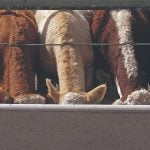Canada’s cattle inventory declined in 2022, with cows and heifers for beef replacement down substantially. Concerns about a second year of drought across the Prairies pushed more heifers into feedlots early in 2022. Prices for fed and non-fed Canadian cattle maintained their upward price momentum from spring to summer on a tight supply outlook, as well as strong demand for Canadian beef. Regional cow slaughter was lower in the West and higher in the East as Ontario retained higher numbers of cows in their herds. The latest USDA crop estimates, with a seven per cent reduction in corn yield compared to 2021, have driven feed grain prices higher following the declines from May to August.
[RELATED] Beef demand reacting to inflationary pressures
Canadian beef herd continues to shrink
Read Also

The Canadian Cattle Association’s international advocacy efforts
Global ag policies affect Canadian food policy, so the Canadian Cattle Association participates in international and domestic forums
Statistics Canada revised their cattle inventory estimates back to 2017, after the May release of the Census of Agriculture data. On July 1, 2022, total cattle inventories were down 2.8 per cent to 12.29 million head. This is the first total herd reduction in three years. Significant herd inventory declines were seen in Manitoba (-6.9 per cent), Saskatchewan (-4.2 per cent) and Alberta (-2 per cent). Heifers for beef replacement were down 7.4 per cent to 622,100 head, heifers for slaughter were down 4.7 per cent to 836,200 head and calves under one year were down five per cent to 3,861,300 head.
The Canadian beef cow inventory declined for the third consecutive year and is the lowest since 2015. The number of cows as of July 1, 2022, was 1.7 per cent below July 1, 2021, at 3.71 million head. Increases and decreases in herd sizes have been seen throughout Canada. Maritime provinces were down 1.2 per cent overall, though Nova Scotia, with the largest regional cow herd, was up two per cent. Central Canada also saw disparities in cow numbers, as Quebec’s cow herd declined 0.9 per cent, while in Ontario, the cow herd increased 3.1 per cent. Provincial beef cow herds also declined in Manitoba (-5.3 per cent), Saskatchewan (-5.6 per cent) and British Columbia (-3.7 per cent). Alberta, with the largest provincial cow herd, increased 1.4 per cent.
Beef heifers for breeding saw a dramatic 7.4 per cent decline in 2022 compared to 2021. High prices for feeder cattle for feedlot operations moved a considerable number of heifers away from cow-calf operations as replacement heifers and into feedlots. Heifer placement as a percentage of total placement averaged 37 per cent in the first eight months of 2022, up from 30 per cent a year ago. Alberta heifer prices as of the week of September 30, 2022, were $39-$53/cwt higher than the same week last year. Heifer prices in the third quarter of 2022 were $17- $30/cwt higher than the first quarter and $18-$34/cwt higher than the second quarter.

U.S. liquidation mode continues
The U.S. cattle herd was in liquidation mode in 2022, as high prices for slaughter cows, combined with drought conditions that covered much of the central and western U.S. states depleted pastures and sent significant numbers of cows to market.
The total number of cattle in the U.S. cattle herd declined two per cent from July 1, 2021, to 98.8 million head. Beef cow numbers declined 2.4 per cent to 30.35 million head, and heifers for beef replacement declined by 3.5 per cent to 4.15 million head, mirroring the movements seen in the Canadian cattle herd. Steers over 500 lbs. declined 1.4 per cent, calves under 500 lbs. declined 2.5 per cent, and the calf crop declined 1.4 per cent. Total calves under 500 lbs. and other heifers and steers over 500 lbs. outside of feed- lots was 2.7 per cent lower than the previous year, at 35.7 million head. Lower supplies of cattle for U.S. feedlots should support Canadian feeder cattle prices into the first half of 2023.

Carcass weights and quality increase
Total slaughter at federally inspected plants was steady with 2021 for the January-August period. Total steer slaughter was down 1.2 per cent, while heifers slaughtered was up 2.6 per cent. Heifers as a per cent of fed cattle slaughter were 37 per cent, 1.4 per cent higher than January-August 2021 and 2.5 per cent higher than the five-year average. Steer carcass weights averaged 916 lbs. in the first eight months, 0.7 per cent (or seven lbs.) heavier than during the same period in 2021 and 2.3 per cent higher than the five-year average. Heavier carcass weights mean that more beef has been produced per carcass than last year, as well as a higher proportion of those carcasses grading AAA or Prime.
Total Canadian beef production from January to August 2022 was 1.7 billion pounds, up 0.6 per cent from the same period in 2021 and up 12.3 per cent from the five-year average. Carcasses grading AAA or Prime totalled 74.8 per cent of all Grade A carcasses, up 4.6 per cent from 2021 and 13.3 per cent higher than the five-year average (65.6 per cent). Canadian slaughter utilization has averaged 94 per cent January-August 2022.
U.S. Prime and Choice production averaged 82.5 per cent of production in 2022, up 2.5 per cent from the five-year average of 80.5 per cent. U.S. slaughter plants caught up to the backlog of cattle in the first half of the year, when steer carcass weights averaged 3.1 per cent above the five-year average at 907 lbs. Since the first week of July, average steer carcass weights are 2.6 per cent above the five-year average at 904 lbs. and are steady with last year.

Beef exports remained strong
From January to July 2022, beef exports were up three per cent in volume and up 16 per cent in value from the same period in 2021. Export volumes increased most substantially to South Korea (+142 per cent), Middle East North Africa (+122 per cent), Japan, (+34 per cent) and Taiwan (+39 per cent). A smaller increase in exports was seen to the EU 27 (+7.0 per cent), Mexico (+4.0 per cent), and the U.S. (+2.0 per cent). Exports declined to Southeast Asia (excluding Taiwan) (-17 per cent), Hong Kong and Macao (-48 per cent), and mainland China (-99 per cent). Total exports for 2022 are projected to be two per cent higher than 2021.
Although the U.S. is still our largest trading partner by far, its share of total exports decreased slightly, as Mexican and Asian markets competed for Canadian beef. Trade to China was halted in early 2022 and has not yet resumed.

Strong Western fed prices, inconsistent Eastern prices
Alberta fed steer prices have been strengthening month- over-month since January, increasing $21/cwt over that time. The September monthly average put Alberta steers at $181/cwt. Strong international demand has been supporting Alberta cattle.
Ontario fed steers struggled to gain consistent traction, though they also increased $9/cwt from January to September. Ontario fed steer prices peaked in June at $191/ cwt, before falling to the $182/cwt range in September.
The Alberta to Ontario fed steer price spread was at its widest in June, with Alberta fed steers at a $17/cwt discount to Ontario fed steers. By September, the price spread had narrowed to -$1.50/cwt, though Alberta fed steers were still at a discount.

Ground beef demand supported cow prices
Cow prices were supported by strong demand for ground beef. D1,2 cows in Alberta rose $37/cwt from their yearly low to their August high of $113/cwt. Ontario D1,2 cows had an even larger climb, moving $41/cwt higher to a June high of $117/cwt. Ontario cows appeared to have reached their price ceiling and have dropped $6/cwt, while Alberta cows continued to put in new yearly highs every month.
Alberta D1,2 cow prices have historically been priced at a premium to Ontario cows; however, they were at a price discount for most of 2022, as western packers prioritized fed cattle slaughter. A very small price premium was seen in August of $3/cwt, one of only two months to date in which Alberta cows were priced higher than Ontario cows. During the first seven months of 2022, Alberta D1,2 cows averaged $4/cwt below Ontario cows. The largest discount was seen in June, with a more than $12/cwt discount. U.S. 85 per cent trim prices have been in the US$250/cwt (C$320/cwt) range to date in 2022, though a general price decline has been seen to the end of August. Softening lean trim prices may bring cow prices down, though inflationary pressures and an increasing cost of living may increase demand for trim meats.

Higher prices for D1,2 cows incentivized producers to cull additional cows. Cow marketings from January to July were up one per cent from last year but remained two per cent below the five-year average. From January to July, Canadian cow slaughter was down four per cent from the same time in 2021 and was down eight per cent from the five-year average. January-to-July slaughter cow exports were up significantly compared to both 2021 and the five-year average. The Canadian cow herd liquidation has put an additional 14 per cent more cows into U.S. slaughter plants compared to last year. Compared to the five-year average, 19 per cent more cows were exported from January to July 2022.
There are considerable differences regionally, as western producers exported more cows to the U.S. Eastern producers opted to retain their cows, as marketings were 11 per cent lower than last year. Total Canadian cow slaughter was down, both compared to last year and compared to the five-year average.

Strong calf prices
Alberta steer calf prices have remained strong throughout 2022, putting in new highs almost every month. Monthly average prices for 500-600 lb. steers were two per cent higher in the second quarter than in the first quarter of 2022 and are another eight per cent higher in the third quarter, to $253/cwt. Alberta auction mart volumes to date are steady with the five-year average, but are nine per cent lower than last year, as summer pastures held up well.
Ontario steer calf prices were considerably choppier than Alberta calves through the spring and early summer. Regional prices have been essentially identical from June to August, with a small price premium for Alberta steer calves. For the third quarter, Alberta 550-lb. steer calves are at a $2/cwt premium to Ontario 550-lb. steer calves.
Demand from U.S. feedlots for Canadian feeder cattle supported prices through the first two quarters of 2022. Weekly live cattle feeder exports have been lower than last year for six out of eight weeks from the middle of July to the middle of September. This has contributed to the drop in steer calf prices seen in recent weeks.

Replacement ratios
Replacement ratios are indicative of profitability. When replacement ratios are high, the potential for a feedlot to be profitable decreases. When replacement ratios are low, the chances of profitability are higher. Replacement ratios were steady in the East from first to second quarter 2022, then increased from second to third quarter 2022. Western replacement ratios decreased from first to second quarter 2022 but increased from second to third quarter 2022.
Replacement ratios were lower in second quarter 2022 than in second quarter 2021 for all classes of cattle in both regions. In third quarter 2022, replacement ratios held steady for 400 to 500-lb. heifer calves in the East, 600 to 700-lb. heifers in the West and increased for short-keep steers in the West compared to 2021’s third quarter. In 2022, replacement ratios were higher, though, for all classes of cattle in the third quarter 2022, than in the second quarter 2022 regardless of region.

Feed grain prices cut margins
After spending the entirety of 2021 climbing to new weekly high prices, due largely to the 2021 drought, Lethbridge barley found its price ceiling early in 2022 near $475/tonne. Statistics Canada estimated total production to be 35 per cent higher than 2021 with a 59 per cent increase in yield. These estimates have eased barley prices, from $469/ tonne in May to $389/tonne in September, though 2022 prices are still 72 per cent higher than the five-year average. Barley prices rose in August and September, as USDA July 1 crop yield estimates failed to materialize amid widespread drought conditions in the U.S. Midwest.
Statistics Canada estimates seeded acres to be four per cent higher than 2021, and total production to be 877,506 metric tonnes, or six per cent higher than last year. Ontario corn reached new weekly highs for the first half of 2022 near $400/tonne, then trended lower on initial USDA crop reports, estimating higher yields through- out the U.S. Corn Belt. Ontario corn prices saw considerable volatility as drought conditions became apparent in the U.S. Midwest, and since the summer low of $305/ tonne, Ontario corn prices have risen 13 per cent. USDA released their summer corn production estimates that were lower than 2021, driving prices higher. Ontario corn was $53/tonne lower than Omaha, providing a feed advantage to Eastern producers.

















